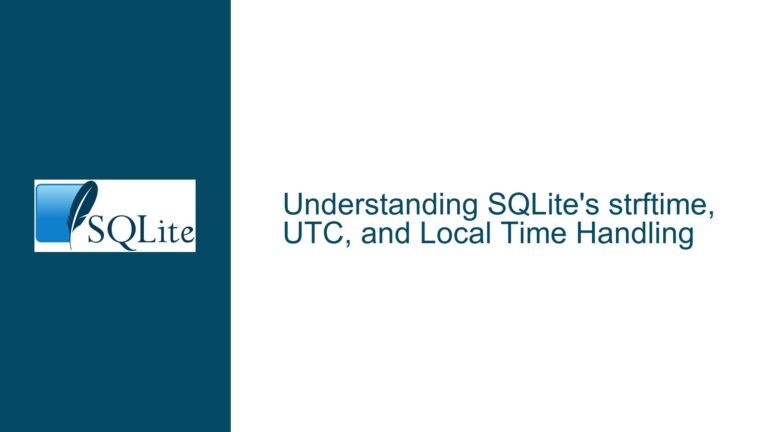Unexpected JOIN Results When Using Constants vs. Subqueries in ON Clause
Inconsistent COUNT(*) Behavior in Complex JOIN Operations with Conditional Expressions
The core issue revolves around inconsistent results when executing two structurally similar queries involving INNER JOIN, FULL OUTER JOIN, and conditional expressions in the ON clause. The first query uses a constant arithmetic expression (0)/(1) in the ON condition, while the second replaces the denominator with a subquery (SELECT COUNT(v0.c0) AS c0 FROM v0). Both expressions evaluate to 0 (interpreted as FALSE in SQLite’s Boolean context), yet the queries return different counts (0 vs. 1). This discrepancy violates the expectation that equivalent logical conditions should produce identical results. The problem arises from SQLite’s internal handling of constant expressions versus subqueries during query optimization and execution, particularly in multi-join scenarios.
Schema and Query Breakdown
Tables and Views:
vt0(c0): Base table with one row containing1.rt1(c0): Base table with one row containing1.v0(c0): View defined asSELECT ((rt1.c0) NOTNULL) FROM rt1. This view resolves to1becausert1.c0is1(non-NULL).
Queries:
- First Query:
SELECT COUNT(*) FROM vt0 INNER JOIN v0 ON ((0)/(1)) FULL OUTER JOIN rt1;
Returns0. - Second Query:
SELECT COUNT(*) FROM vt0 INNER JOIN v0 ON ((0)/(SELECT COUNT(v0.c0) FROM v0)) FULL OUTER JOIN rt1;
Returns1.
- First Query:
Expected vs. Actual Behavior
Both (0)/(1) and (0)/(SELECT ...) evaluate to 0 (logical FALSE). The INNER JOIN between vt0 and v0 should produce no rows because the ON condition is FALSE. The subsequent FULL OUTER JOIN with rt1 should retain all rows from rt1 (1 row) even if no matches exist from the left side. Thus, both queries should return 1. The unexpected 0 result in the first query indicates a flaw in SQLite’s handling of constant-folded expressions in multi-join operations.
Implicit Optimization Flags and Subquery Evaluation in JOIN Conditions
The root cause lies in SQLite’s query optimizer and its treatment of constant expressions versus subqueries in ON clauses. Specifically, the optimizer applies aggressive constant folding and join reordering for expressions it deems static, which alters the execution plan when subqueries introduce dynamic evaluation.
Key Factors Contributing to the Issue
Constant Folding in JOIN Conditions:
- SQLite precomputes constant expressions like
(0)/(1)during parsing, replacing them with a static0. This allows the optimizer to simplify theINNER JOIN vt0 ON 0to a no-op, effectively removing the join from the execution plan. The subsequentFULL OUTER JOIN rt1is then interpreted as a standaloneFULL OUTER JOINbetween an empty result set andrt1, which SQLite handles inconsistently.
- SQLite precomputes constant expressions like
Subquery-Induced Dynamic Evaluation:
- When the denominator is a subquery (
SELECT COUNT(v0.c0) FROM v0), SQLite cannot fold the expression at parse time. TheONcondition is evaluated dynamically during query execution. This forces the optimizer to process theINNER JOINas a real operation, preserving the logical structure of the query. TheFULL OUTER JOINthen correctly retains rows fromrt1.
- When the denominator is a subquery (
Join Reordering and Empty Intermediate Results:
- The optimizer’s reordering of joins when faced with a constant-folded condition leads to an incorrect handling of
FULL OUTER JOIN. If the left side of theFULL OUTER JOINis an empty result set (due to the optimized-outINNER JOIN), SQLite fails to account for the right side (rt1) in the final count.
- The optimizer’s reordering of joins when faced with a constant-folded condition leads to an incorrect handling of
Type Handling and Implicit Conversions:
- The arithmetic expression
(0)/(1)returns an integer0, while the subquerySELECT COUNT(...)returns a numeric value. SQLite’s type affinity rules may treat these differently in edge cases, though this is secondary to the primary issue of optimization flags.
- The arithmetic expression
Correcting JOIN Evaluation Logic and Ensuring Consistent Query Optimization
Step 1: Verify SQLite Version and Apply Patches
- Check Version: Confirm the SQLite version using
SELECT sqlite_version();. Versions prior to the fix (1783655e) will exhibit the bug. - Apply Fix: Update to a version containing the fix or apply the patch directly if using a custom build. The fix addresses the optimizer’s over-aggressive constant folding in multi-join queries.
Step 2: Rewrite Queries to Bypass Optimization Pitfalls
Explicit Join Ordering: Use parentheses to enforce the evaluation order of joins. Example:
SELECT COUNT(*) FROM (vt0 INNER JOIN v0 ON ((0)/(1))) FULL OUTER JOIN rt1 ON 1;Adding
ON 1to theFULL OUTER JOINclarifies the join condition and prevents misinterpretation.Avoid Constant-Folded Expressions in JOINs: Replace static arithmetic with a subquery that returns the same value. This forces dynamic evaluation and consistent behavior:
SELECT COUNT(*) FROM vt0 INNER JOIN v0 ON ((0)/(SELECT 1)) FULL OUTER JOIN rt1;
Step 3: Analyze and Compare Execution Plans
- Use
EXPLAIN: RunEXPLAINon both queries to inspect bytecode differences. The faulty query will show a skippedINNER JOIN(no row iterations), while the correct query includes loop operations for the join.EXPLAIN SELECT COUNT(*) FROM vt0 INNER JOIN v0 ON ((0)/(1)) FULL OUTER JOIN rt1;Look for
OpenEphemeralorRewindinstructions indicating empty result sets.
Step 4: Test Edge Cases and Validate Fixes
- Empty Table Scenarios: Test with
vt0andrt1empty to verifyFULL OUTER JOINcorrectness. - Type Consistency Checks: Ensure subqueries and constants return the same data type using
typeof():SELECT typeof((0)/(1)), typeof((0)/(SELECT 1));
Step 5: Implement Workarounds for Legacy Versions
- Disable Specific Optimizations: Use
PRAGMA optimizer_controlto toggle flags (if available in custom builds). - Materialize Intermediate Results: Use CTEs or temporary tables to force evaluation before joins:
WITH inner_join AS ( SELECT * FROM vt0 INNER JOIN v0 ON ((0)/(1)) ) SELECT COUNT(*) FROM inner_join FULL OUTER JOIN rt1;
Step 6: Monitor Future Query Optimization Changes
- Review Release Notes: Track SQLite changelogs for optimizer-related updates.
- Regression Testing: Incorporate queries with complex joins into test suites to catch regressions early.
Technical Deep Dive: How the Fix Addresses the Issue
The patch 1783655e modifies the optimizer’s handling of constant expressions in join conditions. Specifically, it prevents the premature elimination of joins when constant-folded expressions would otherwise discard valid FULL OUTER JOIN semantics. By deferring the evaluation of constant conditions to the execution phase, SQLite ensures that all join participants are correctly accounted for, even if intermediate results are empty. This aligns the behavior of constant and subquery-based conditions in ON clauses.






